#for context. i usually enjoy drawing a lot of line heavy illustrations
Text
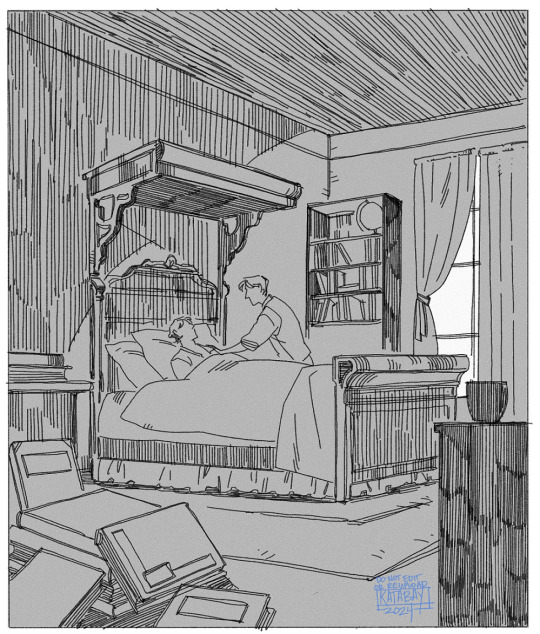
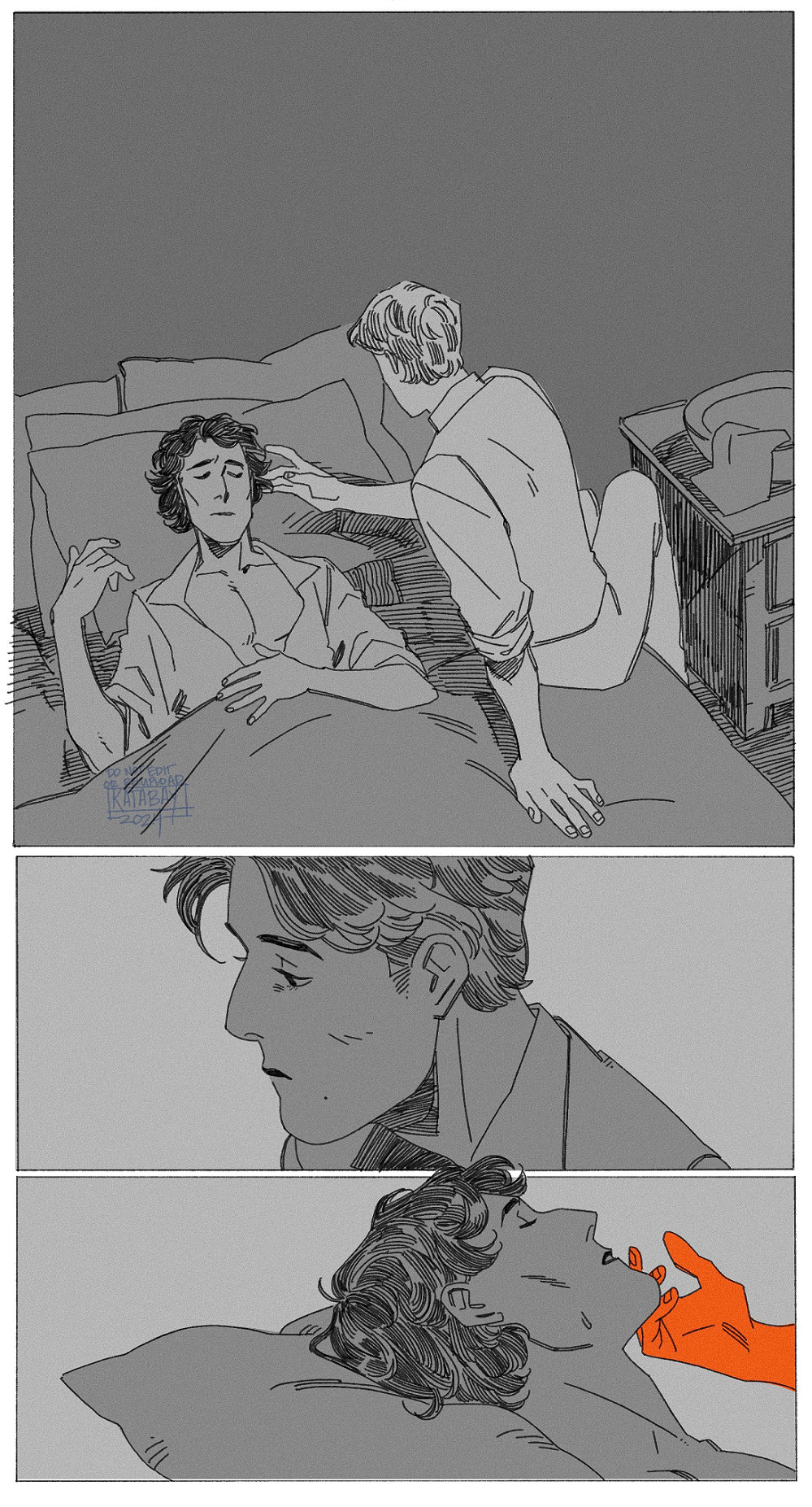
MY DEAR VICTOR
“My dear Victor,” cried he, “what, for God’s sake, is the matter? Do not laugh in that manner. How ill you are! What is the cause of all this?”
“Do not ask me,” cried I, putting my hands before my eyes, for I thought I saw the dreaded spectre glide into the room; “he can tell. Oh, save me! Save me!” I imagined that the monster seized me; I struggled furiously and fell down in a fit.
Poor Clerval! What must have been his feelings? A meeting, which he anticipated with such joy, so strangely turned to bitterness. But I was not the witness of his grief, for I was lifeless and did not recover my senses for a long, long time.
This was the commencement of a nervous fever which confined me for several months. During all that time Henry was my only nurse. I afterwards learned that, knowing my father’s advanced age and unfitness for so long a journey, and how wretched my sickness would make Elizabeth, he spared them this grief by concealing the extent of my disorder. He knew that I could not have a more kind and attentive nurse than himself; and, firm in the hope he felt of my recovery, he did not doubt that, instead of doing harm, he performed the kindest action that he could towards them.
Frankenstein; or, the Modern Prometheus, Mary Shelley (CHAPTER 5)
ah, to be cared for! the unconditional depth and gentleness of it. also have you guys ever listen to the ost for the korean frankenstein musical. sometimes I think about how musical!victor uses his henry's (dupre in the musical, not clerval, but henry all the same) head for his creation. that's also an unconditional something!!
ngl I considered attempting a full bernie wrightson homage for this, but then I thought about how I like having fun and that would totally ruin my hands for the week and settled for drawing a bunch of lines until I got tired of drawing lines lmao
ko-fi⭐ bsky ⭐ pixiv ⭐ pillowfort ⭐ cohost ⭐ cara.app
#mary shelley's frankenstein#victor frankenstein#henry clerval#komiks tag#for context. i usually enjoy drawing a lot of line heavy illustrations#i do most cross hatching by hand and just. really love drawing lines#however. bernie wrightson's frankenstein illustrations are operating on a whole different level of Goddamn#i did a master copy of one of them once and couldn't draw for two days after i finished#which is an extremely unrecommended condition to find yourself in which is why i gave up on trying to achieve a similar art aesthetic#i do find myself going back to edward gorey a lot tho
728 notes
·
View notes
Photo
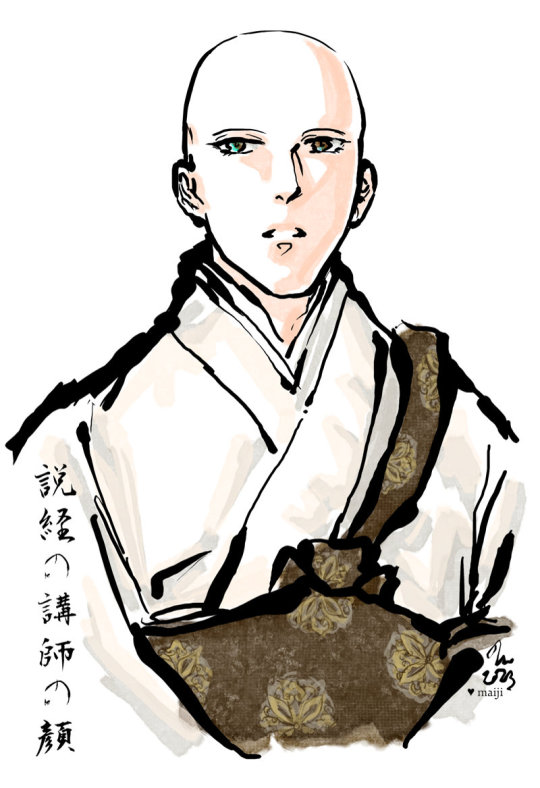
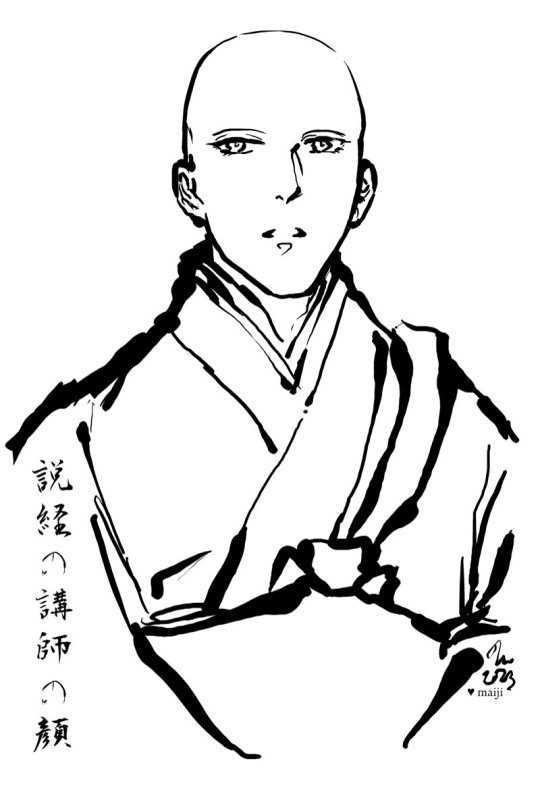
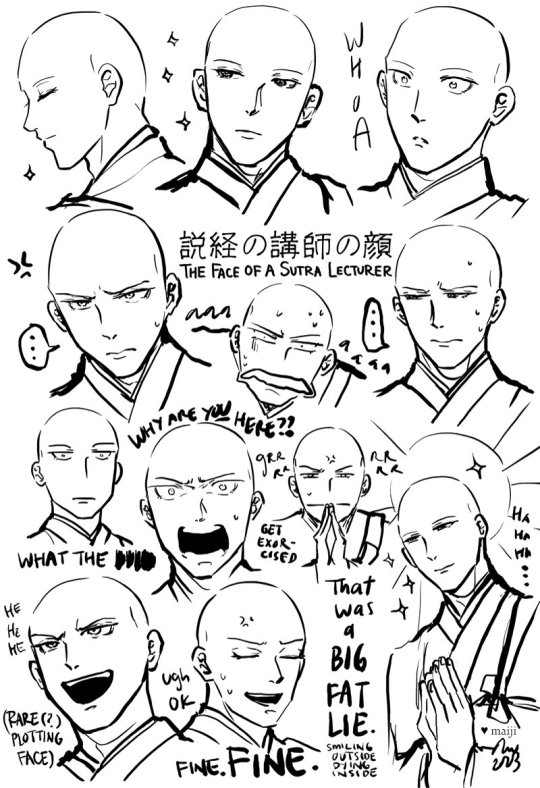
[image set: 1) Digital ink brush-and-watercolour-style illustration of the Buddhist monk Byakken from Nubatama wa Oujou Shinai in ceremonial robes. His lifted head, hooded eyes and slightly open-mouthed expression give the impression that he is in the midst of giving a talk. 2) Same illustration, but with only the lineart. 3) Byakken with a variety of facial expressions, looking serene, shocked, stressed out, annoyed, etc.]
説経の講師は顔よき。講師の顔をつとまもらへたるこそ、その説くことの尊さも覚ゆれ。
- Sei Shonagon, 枕草子 (Makura no Soushi / The Pillow Book)
“A priest who gives a sermon should be handsome. After all, you're most aware of the profundity of his teaching if you're gazing at his face as he speaks.”
[translation by Meredith McKinney (2006)]
"A preacher ought to be good-looking. For, if we are properly to understand his worthy sentiments, we must keep our eyes on him while he speaks [...]”
[translation by Ivan Morris (1967)]
More commentary below the cut!
I chuckled at this quote from The Pillow Book (and the entire story built around it) in Nubatama wa Oujou Shinai. (If you’re unfamiliar with The Pillow Book, it very much is like reading the blog of a thoughtful, witty court lady from the Heian era! Sei Shonagon can be quite tongue-in-cheek, even sarcastic, and in a lot of ways it’s amazing to see how little humanity has changed over a thousand years.) I also thoroughly enjoyed drawing Byakken-sama in ceremonial robes!
On the topic of faces, one of the many reasons I love Byakken is because of his extremely relatable facial expressions. Kuze Banko gives him a lot of these perfectly serene expressions, but also has no problems pulling him in extremely over the top directions too - usually from shock or stress, he seems to get into those kinds of situations very easily lol. I feel his emotions one hundred and ten percent! Because of the well-done range and writing, it really gives you the impression that even his serene expressions have something more behind them (like exasperation, resignation…).
For example, the (very minor early story spoilers!) context for “That was a BIG FAT LIE” (smiling outside, dying inside) is that Nubatama happily tells all the sobbing wailing people in her household that she decided to become a nun because she was so profoundly moved by Byakken-sama’s preaching and decided to leave the material world behind. Which as we know is a complete fabrication especially since Byakken spent most of his time with her arguing with her about why she shouldn’t become a nun. But everyone who hears the story is like hmm yeah!! That makes total sense!!!! And thus The Amazing Tale of How Princess Nubatama Was Inspired To Become A Nun gets around. The panel that cuts to Byakken standing in front of a bunch of people talking about this, with his beatific Mona Lisa smile that somehow manages to be really flat at the same time, captioned with a giant USO (“lie”) kanji, is pitch-perfect. The entire setup and background gives him this impression of “Ah, yes… that familiar feeling… of THE DESIRE TO COMMIT MURDER”. Every time I look at it, I laugh.
It was a good challenge attempting all the different faces while still trying maintain a sense of consistency about the character, especially thinking about how I would render him differently relative to all the other Buddhist monk characters I also draw. I tried to manage that through his eyes - his very expressive eyebrows, heavy lids, and the little lashes at the corners of his eyes and his lower lids, and some of the dips/head shape near his temples. It’s also interesting to click between the colour and the ink/line-only versions and see how the effect of an image can change subtly, yet noticeably once you bring in shading and colour.
#digital art#fanart#nubatama wa oujou shinai#the pillow book#sei shonagon#byakken#art by maiji/mary huang#heian#kuze banko
5 notes
·
View notes
Note
Hi Allie! I wondered if I could ask you for some advice. I want to draw really badly and create art but I really don't have any skill! I know that in order to get better at art I have to actually do it, but I feel so overwhelmed by how I'm not where I want to be with it right away, and also with where to start with learning to draw. Do you ever feel that way when you draw? And if you do how have you gotten past it?
[I am literally so sorry this is so long oh my God. My mind has been very jumbled lately so I accidentally rambled too much, but I hope it still helps you in any way orz] Oh sweet little anon.. ;^; I do feel that way, a lot of the time if not all of the time! Just recently this week, I felt like I just couldn't draw despite picking up my pencil and scribbling, it just wasn't working partly for that exact reason! Overwhelmed by not being where I want to be with it! These things happen and its frustrating. It's hard for me to imagine as a beginner artist because I've been drawing since I can remember but I will still do my best to offer you some meaningful advice!
But first, to answer your very last question, getting past it can be a little random sometimes. This whole week after being unable to draw, I was laying in bed trying to sleep while reflecting on some heavy feelings ive been having and memories. Suddenly part of an image flashed in my mind and I got up to immediately try drawing it. (The drawing I recently posted and captioned "parade"!) I worked on it completely driven by my heart, and so it didn't matter at the time if it looked good or was anatomically correct, etc. Right now I am working on another heart-driven drawing, but if I tried to work on lets say a study or character drawing instead.. I dont think i could!
My point in all this is that, I think that its important to know/understand why you want to create art, and I think my advice would change slightly depending on your answer. For me personally, I am an emotional artist. I create art that (usually) reflects how I'm feeling or topics I am emotionally drawn to. Illustrations, drawing characters, writing comics, etc.. I think this week, while I'm definitely struggling with my skill level, I was so burdened by some things I've been feeling lately that I couldn't focus on or enjoy anything that I was trying to create, until I was able to release it all in a drawing. (And I'm still not done with them hence why I am now working on another related drawing, but im making SOMETHING and feeling passionate which cannot be said with any of my other attempts this week.) So since these drawings purpose outweigh my current issues regarding my skill, I am able to work on them. If that makes sense?
Okay im sorry with how long-winded this all is so far and all about myself orz but I wanted to give context on how I view art and I think if you asked someone who creates like. Hyperrealistic drawings their answers would be completely different. So! I wanted you to be able to judge if my advice would work for you if that makes any sense at all...!!! Moving on to my actual advice then..!
This is a little general ofc because I dont know what sort of art you are creating, or what your passion behind it is. And if after this you would like to tell me more about your art I would love to hear! 🥺💗 you are welcome to dm me or if you send another anon/ask i think that would be good too since.. well other artists who see can also give their own advice too!
Okay. So anyways lol, first I want to tell you that your desire to create art makes you an artist, despite your skill level. And therefore, everything and anything that you make even now has value. Even if right now you're drawing wonky shaded spheres and cubes! I understand its frustrating when wanting to make something but you feel like your skill isn't "there" and how that can prevent you from making anything to begin with!! But I really want you to try and work through it! Ignore it, disregard it, give your worries about your skill the silent treatment!! And I know its near impossible to do but if its getting in the way of you actually creating well.. thats the worst! We can't have that. If you really want to draw, then you really NEED to draw, you know what I mean? You deserve to draw! The hardest part for like 80% of artists is working around their skill level. I promise you will get there, but for now, you can't let it get in your way. And I realize me saying "oh you feel like you're not good at drawing and its hindering you from doing it? Just do it" sounds like Chad advice but ;---; unfortunately its the reality that comes with being an artist. If you tell me more about what you like to/why you want draw then maybe we can find some alternate lines of thinking that will help you (for example "this tiger i drew looks like shit but drawing all of her stripes was therapeutic and made it worth it!" If lets say you draw as a stim, opposed to "this tiger im drawing looks so bad I can't even look at it anymore " dhsjhd I really hope that this all makes sense lol.)
Moving on, learning how to draw.. this also depends on what you enjoy drawing but my main piece of advice here is study from real life. I grew up drawing cartoons and anime, and now that I want to draw a little more realistically.. its so hard!! If you study real shapes/people/animals/etc it might be easier later on when you understand fundamentals to bend them if you decide to create stylized or surreal art. However if right now you like to draw stylized art, I would recommend to keep working on your personal style while studying from real life on the side simultaneously! Any way you look at it, understanding how shapes, lighting, colour, etc work in the real world will help you out even with the most obscure pieces. And since art is a learned skill yknow you need to build those brain..pathways..and such. Im not a scientist but you get what i mean. Studies are the equivalent to lifting weights! I would recommend the website quickposes (com) they have a library of images that they throw at you at random. The site can explain itself better than I can lmao, check it out!!!
I really hope i was able to offer you something of value here, I didnt mean to ramble so much. I'm excited for you to grow as an artist, I love when I hear about others deciding to learn how to draw ;-; please feel welcome to ask for any clarification (as im having a hard time articulating my thoughts lately) or if you really just want to ask or say anything! ♡♡♡ again sorry if this was more than you bargained for length wise dhsishskshksj
#im wishing you the best anon!!! you can do it!!!#and im 100% serious please feel welcome !!#also if any other artists want to chip in I think it would be fun! ♡
11 notes
·
View notes
Text
A piece-piece nyana review to J Bob’s Kool Hip Hop Theatre. By Rethabile Headbush
Jeff Tshabalala, better known as J Bobs is the Standard Bank Young Artist Award winner for Theatre and Seen Pha is a fresh salad of poetry, hip-hop, comedy and traditional dramatic arts. There is Simphiwe Bonongo’s unreal beatboxing, a random hip-hop “holla” here and there, KWASHA in “communicating” hip hop combos and J Bobs at the centre of it. Seen Pha is fun, it’s flavourful and is an experiment of where J Bobs is taking sketch work next.
Chapter 6’s The Darkie Author is a reading, and discussion in response to Chapter’s 3’s The Money. The Whites. The Reviews. as Tshabalala puts it, “to talk about our problems on our terms”. The Darkie Author deals with issues in South Africa’s creative arts industry specifically the typecasting of black characters in White headed film, TV and theatre. It is also an insight into the direction he would like to take his work: taking the traditional theatre and “boom bap it – I’m gonna swag it up a little bit” as he puts it, make it interesting, cool and happening, evident in his hip hop inspired poetic pieces.
Chapter 10: Catchy Sing along 1 is an example of this. Tshabalala parodies your gold- chain-wearing, narcissistic wannabe rapper, aspiring for fame – J Bhoboza who is presented to us, arms flailing, shades wearing, guarded by his almost but not so quite two-man entourage/bodyguards in Chapter 10. The songs are truly catchy – so catchy his bodyguards can’t help but join. This piece is an intro to J Bhoboza, the woman loving (or stealing), artist vying for fame and not so concerned with the real issues of our reality. He makes this clear in a line where he raps “You won’t catch me reading and my subject matter’s weak. You’ll never hear me reading or in a scuffed sneak”.
Chapter 10 is as funny as it is catchy, poking fun at your rapper, more concerned with image and stardom than current affairs and we see it continue into J Bhoboza’s Chapter 13: La Khot del Swag. Chapter 11’s Catchy Sing Along 2 features Deevision (KWASHA’s Dinsthitile Mashile). Here, Deevision raps her own swaggerific interpretation of claim to fame, focusing on the dilemma of choosing between studying and stardom which often feel separate. She shares in her line “I don’t wanna train – I was born a star”. In it, we see continued the parodical theme established throughout J Bhoboza’s pieces and songs.
Chapter 15 is the Ubhoboza Podcast (towards Mzansi Hip Hop theatre) presented by J Bobs himself as a 50-minute podcast, breaking down the ideas and inspiration behind the varying skits and sketches. He introduces Location, Lekayshini, Lokasie, a game show exploring modern vernacular language in South African townships or Kasi taal. It is evident that it inspires much of his writing style, as he draws on contemporary South African issues in his work. The podcast also includes the story and inspiration behind the character and persona, J Bhoboza inspired by the rap cyphering culture and rap style of Black cyphers in suburban Johannesburg.
The J Bhoboza rap features the two UBDope Bursary recipients, Sydney Ndhlovu and Tshepo Matlala who play J Bhoboza’s body guards. We also see them in conversation with J Bobs, discussing his writings The darkie Author and To Wits or to Vurtz?. Tshabalala briefly breaks down the methods he uses in his sketches and the way he used rhymes to address real and pertinent social issues in a playful, engaging, and entertaining framework. Chapter 9: To Wits or to Vurtz does the same, by introducing his personal experiences which led him to the piece-piece nyana skits and songs we see in Seen Pha. Here, he also reflects on his personal experiences and finding Black voices that inspire his work.
Chapter 5, 7 and 8 are songs ranging between rap and poetry from the Market Theatre’s KWASHA who are either responding or adding their own twists – as seen in Chapter 4’s Side Chick Makhwapeni performed by J Bhoboza. The J Bhoboza rap skit parodies issues of infidelity “side chick” relationships in our society. The songs range between 1 and 4 minutes and are produced by Nkululeko “Muchacho” Nkosi. Chapter 14’s Bheja S’jole, featuring Moose Goose and All Hit Wonder, is a song illustrating relationships revolving around the exchange between sexual favours and money – a theme shared with the Side Chick/Dick Makhwapeni songs. Chapter 12: These broken feelings, sung again by Moose Goose and All Hit Wonder, also features the talents of Mosie Mamaregane and Wonder Ndlovu of KWASHA. It is a one minute melodic interlude responding to and closing the Makhwapeni raps and songs. The two KWASHA members flaunt their vocal range in this chapter. KWASHA transform into various roles in Chapter 17: Location. Lekeyshini. Lokasie., poets, rappers and collaborative artists in various versions and adaptations of Tshabalala’s works, contributing their own verses and perspectives in response to J Bhoboza’s Makhwapeni raps with just as much swagger, energy, and flair as Bhoboza himself.
The L.L.L game show is introduced with a musical mix of song and rap sung by KWASHA and vocal special effects by Beats eMlonyeni (Bonongo). A few of the songs like, “bheja s’jole” and “bimba for you” are familiar to the viewers by this chapter of Seen Pha. Just like the songs, the game show is led by J Bobs. Location. Lekeyshini. Lokasie. brings relatability, play and engagement into live performance. Tshabalala experiments with another kind of “play” to motivate his inquest into finding new ways of presenting and sharing theatre. The games played in the show create awareness and celebrate the uniqueness of township modern vernacular (demotic) languages or Kasi Taal, usually characterised by the adoption of numbers or words from colonial South African languages – like English or Afrikaans – and used with very different meaning and context, amongst other traits. The Translation and Decode English games illustrate this well with examples like “nine nine”, “nerves” and “tiger” which can be generally translated to “on point”, “stress” and “ten Rands” respectively, as illustrated in the show. Overall, this game ties in well with Chapter 18: Victor and the Vernacs to Mogodu or to Haggis that is the Conundrum, which uses modern vernacular language and politics around naming and renaming in South Africa.
Chapter 18 takes place at a Monday meeting between writers for the writing of The Darkie Author, a story written by J Bob. This pieces is read by the KWAHSA members and explores issues around the making of Black characters in White headed writing teams in South Africa. It highlights how White ignorance towards the Black South African experience influences problems such as typecasting- directly addressed in The Darkie Author. It poses the question of how problematic such structures can be in limiting the representation of Black characters in the industry and continues into another reading in Chapter 19: Victor and the Vernacs (Kale Tuesday). The reading is presented simply, we see KWASHA seated on high chair and Tshabalala at a desk between them introducing the piece, his signature pink suitcase in the background.
With Victor and the Vernacs, Tshabalala, the language and word-play wizard, uses his writing to bring colour to the members of this writing team especially seen through character, Victor. Victor’s expertise in his position as head writer is just as questionable as how he landed the job in the first place. Victor, played by KWASHA’s Joel Leonard, spends most of the brainstorming meeting being racially inappropriate and objectifying the women of the team. We see this in one line where Victor comments, “You okes like to think that everything is a mix-tape – my people say Pretoria, you lot tune Tshwane. My people say Grahamstown, your lot tune your khandas together and come up with Makhanda”, illustrating both Tshabalala’s strong and consistent theme in the political and social context of South Africa and his lovely play with words like “khanda” and “Makhanda”.
Seen Pha is an experimental mix masala of Tshabalala’s work made specifically for the vNAF stage. Tshabalala gave us a piece-piece nyana of everything, sharing his range as a creative, theatre maker and sketcher. Though numbered, the chapters do not follow an order and often jumps between different skits, songs, readings, and discussion. The way Seen Pha has been curated is to provide, what seems to be, musical breaks between text-heavy pieces, creating a satisfying and engaging rhythm for the audience. I thoroughly enjoyed the entertainment of the wordplay and relevance of both Victor and the Vernacs readings, the musicality and vocals of the Side Chick Makhwapeni 2 and 3 versions, the Ubhoboza podcast for its insight into Tshabalala’s process and The Darkie Author’s response to relevant questions around the structure and politics of South Africa’s creative industry. I am most interested to see all his experimentation and sketches establish themselves into physical pieces and see his idea of Hip-Hop Theatre come into a live stage realisation. You can find Seen Pha kwa J. Bobs anytime on the National Arts Festival website. Since the extension of certain vNAF programs, all 20 chapters are still open to watch at any time, on any day, for free until the 31st of August. Be sure to catch it when your data and Wi-fi bundles agree and pick your favorite piece-piece nyana combos.
1 note
·
View note
Photo


Writer: Charles Soule Artist: Goran Sudžuka Colourist: Matt Milla
“The Seventh Day” begins in Daredevil #15, following up on the traumatic events of the previous “Dark Art” story-arc that left Daredevil’s protégé, Blindspot, in the hospital with life-changing injuries.


There is a lot of guilt in this issue and Charles Soule lays it on thick. There’s Matt Murdock’s guilt over failing Blindspot and having him wind up in the hospital, but it’s compounded later by Matt going to confessional and adding Catholic guilt to the mix. It’s ultimately kind of bleak and feels rather heavy-handed.
Now, I have to say that I enjoy darker Daredevil stories, I’ve always felt that he’s a character that lends himself to more serious stories that go to deep, emotional places. That’s not really what I see here. Soule instead seems to be pushing Matt into a situation where he’s set himself up for suicide-by-supervillain and that just seems extreme.
Given the reveal at the end, maybe it was to draw someone out, but it ultimately feels like an irrational decision based on guilt. There’s a parallel drawn with one of the would-be-assassins attempting to claim the bounty Daredevil puts on himself, through the guilt and anger he feels over the loss of his wife and his son’s losing the use of his legs, but it’s cut short in the confrontation, with an ending that will likely only lead to more guilt on Matt’s part. It also seems even more irrational when you think about events in Matt’s life, some of which are recapped through his thoughts at the church, for which he’d feel even more remorse and responsibility.


Somewhere during the “Dark Art” story-arc--most noticeably during the big Inhumans guest-starring issue, but it started a bit in the second part of the arc--Matt Milla started using a more elaborate colour scheme. The colours were still muted, and there were still dotting effects for shading and colouring, but it was closer to “normal” palette. Here in the first part of “The Seventh Day”, the stylistic effect that the rest of the series has seen is gone and Milla is using a fairly flat, “normal” colour scheme.
I miss the stylistic flair. It really set the book apart and now it just looks like any other comic.
That’s not to say that the artwork looks bad, that’s impossible when the story is illustrated by Goran Sudžuka, just that one of the things that made Daredevil distinct has been lost this issue.
For his part, Sudžuka’s art is great and it’s nice to see him trading off arcs again with Ron Garney, even if this is just another short two-parter. He provides a nice, clean style ample with solid black shadows that suits the world of Daredevil.

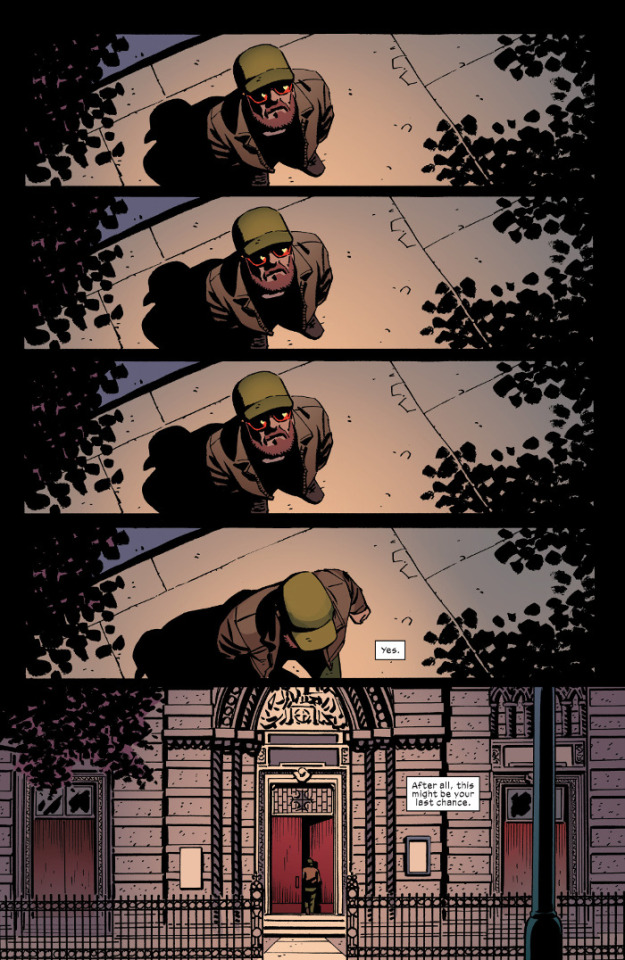
Ultimately, this is probably my least favourite of Soule’s run on Daredevil so far. I’ve really liked everything up to this point, so there’s no fear of me dropping the title, but the first part of “The Seventh Day” is kind of a weak point. There are some nice things in following up on the end of “Dark Art”, and there’s an attempt from Soule to have Matt do some soul-searching after how detached he’s been throughout a large part of the run, but the guilt... The guilt is just heavy and how Matt’s dealing with it feels odd. Sudžuka delivers some great art, though.
Although I would easily recommend Soule’s Daredevil from the beginning, and despite this issue being relatively easy to slip into with previous necessary information being provided, I wouldn’t recommend starting here. The emotional resonance that would inform the story is lacking for new readers and I’d suggest starting at the very least with the “Dark Art” story-arc that began in #10, if not from the beginning of this volume.


Writer: Brian Michael Bendis Artist: Sara Pichelli Inking Assist: Gaetano Carlucci Colourist: Justin Ponsor
Spider-Man #12 kicks off a crossover with Spider-Gwen that sees Miles dimension-hopping over to Gwen’s Earth to track down his father, who has gone missing after being sent on an off-the-books mission from Maria Hill and SHIELD. Technically, the story started last issue, focusing on Miles’ father’s training before being sent on the mission, but it’s not necessary to read for the enjoyment of this story.


Brian Michael Bendis tells this story as a story being told by Miles to his roommates, which in one fell swoop allows for the possibility of an unreliable narrator and a reason for some of Bendis’ telltale dialogue quirks of characters sounding the same and different people repeating the same lines of dialogue.
In regards to the first point, it sets up both the sequence of Miles and Gwen making out in a more suspect light. It could just be Miles trying to show off to his friends and fabricate a story as to how his meeting with Gwen occurred. It certainly goes a ways to make the idea of a twenty-something Gwen making out with a teenage Miles a little more acceptable, although I’m not sure anyone reasonably thought about that aspect of the pairing through with the promotion and advertising I’ve seen for the issue.
It also goes to explain how obsequious Maria Hill seems to be in recruiting Miles to search for his father, even if that doesn’t necessarily make a lot of sense given how much of an infodump her dialogue seems to be.
The second point of Bendis’ dialogue quirks, while explained away by the storytelling nature of the framing narrative, is still a repeated dialogue quirk present in most of his writing. There’s an in-story explanation for it here, even if it’s not explicitly spelled out, but to those who may be tired of the same dialogue beats, they’re still present here.


As to the story itself, this issue is almost entirely set-up. It’s mainly Miles telling Ganke and Goldballs how he embarked on his dimension-hopping search for his father, a brief run-in with Earth-65′s version of The Ringer, and then running into Spider-Gwen for the cliffhanger.
There’s a bit of humour and some nice characterization for Miles through his narration to his friends, but there’s not a lot of forward momentum beyond setting up the situation, something that was already pretty much done in a single page last issue.
Sara Pichelli’s artwork is nice, though. Particularly nice is Maria’s rocket boots, a bit of Earth-65′s alternate take on New York’s Chinatown which also gives colourist, Justin Ponsor, a chance to show off some neon glow, and her take on Spider-Gwen herself.


While it may seem that I didn’t like this issue, it actually is fairly entertaining. If you’ve grown to dislike Bendis’ dialogue, this isn’t for you, but if you still do, it’s not a bad issue of set-up. It is heavy in exposition and can be seen as an over-extension of something that was essentially accomplished by a single page previously, but it is entertaining. Whether or not the story will be fleshed out more, and given a different perspective or context from Gwen’s point of view, remains to be seen.
Bendis’ Spider-Man can still be fun, and you get the impression that he’s more invested in telling stories with Miles than several other of his current titles, which results in a bit deeper characterization and storytelling.


Writers: Ryan North, Will Murray (15-year old sequence) Artists: Erica Henderson, Steve Ditko (costume illustration) Colourist: Rico Renzi
For Squirrel Girl’s 25th anniversary, The Unbeatable Squirrel Girl #16 celebrates her 20th birthday with snippets of her life story, told in five year intervals. It starts with her parents and then ends with a possible future.


Ryan North (with help from Will Murray in a sequence I’ll get to late) tells the story of “Squirrel Girl in a nutshell” over the course of five vignettes and an epilogue, beginning with a montage of her parents meeting, going through the usual courtship period, and finally with Doreen’s birth.
It continues on, mainly focusing on Doreen’s birthdays, at five, ten, fifteen, and finally twenty as we see how her squirrel powers manifest, how she first realises that she can talk to squirrels, how she was inspired to use her talents as a superhero by her first squirrel friend, Monkey Joe, how she helped the Hulk defeat the Abomination, and, finally, her current twentieth birthday party attended by a number of Marvel’s heavy-hitters.
North does a great job of spreading humour throughout the book, but I think one of the more important things he does is impart a message to children during the 10-year old Doreen sequence. Not only does he show that anybody can really be a hero with what they’re given, if they can accept who they are and what they have, but also that children shouldn’t give up on dreams or possibilities, just because they’re kids.


Squirrel Girl co-creator Will Murray also writes a six-page sequence of Doreen when she’s 15 of her encounter with the Hulk and the Abomination that is as funny as most of what North presents throughout the book. A blind Hulk in a fight with the Abomination being led by Squirrel Girl’s commands is rather amusing.
It’s also interesting to see Erica Henderson adapt to both the time-period for Doreen’s costume and to the different style of Murray’s writing and more numerous panels, without it at all seeming out of place with the tone or style of the rest of the book.
Henderson’s artwork, as usual, can be something to get used to. She has a habit of drawing “ugly” faces, but it’s a style that suits the offbeat nature of the title and she’s excellent at portraying action, humour, and animal antics, particularly on display in both the Hulk sequence and in Doreen’s rescue of Monkey Joe from a corgi in the panels above.

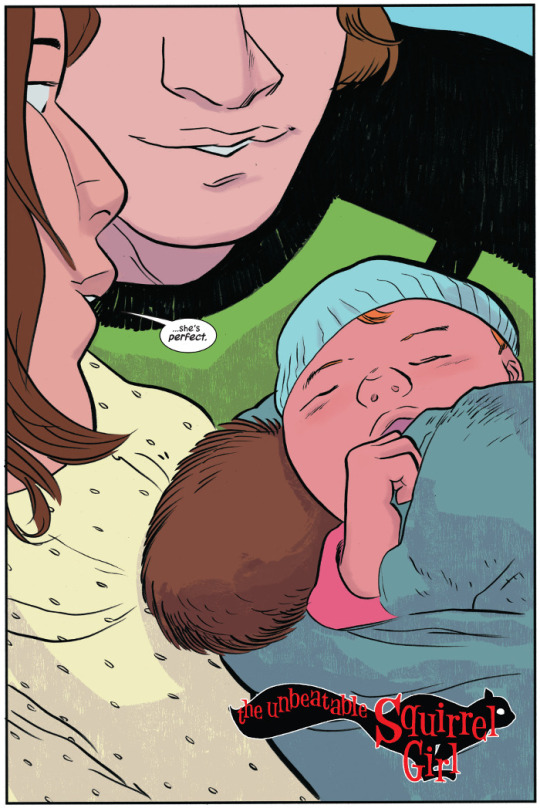
Unbeatable Squirrel Girl #16 is an excellent introduction to the world of Squirrel Girl for new readers, giving them a leg up on Doreen’s history as well as the quirky and fun style that North and Henderson employ on the title. Between this issue and last issue’s focus on Nancy’s cat, Mew, there are two wonderful ways to ease yourself on to the series with strong, solid stories.
I’d recommend this to anyone who wants to see what the fuss is about one of Marvel’s quirkier, funnier titles, as well as anyone who just likes offbeat superheroes.

Next: More spiders! And monsters most likely.

d. emerson eddy has never been to the beaches of Ipanema and, perhaps sadly, doesn’t know a girl from there either. He has, however, seen a baby elephant walk.
#Monday#Marvel#Daredevil 15#Charles Soule#Gordan Sudzuka#Spider-Man 12#Brian Michael Bendis#Sara Pichelli#Unbeatable Squirrel Girl 16#Ryan North#Will Murray#Erica Henderson#posts by d. emerson eddy
1 note
·
View note